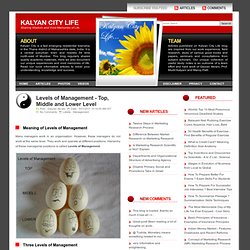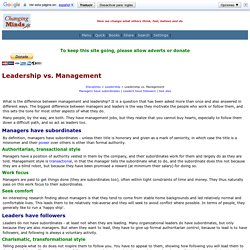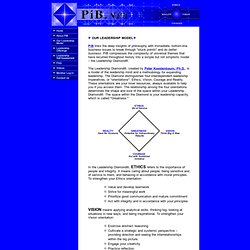

Leadership - Management Education - Wsj.com. Level of Work and Role Complexity. The Benefits of Understanding this Concept: You can make universal, apples-to-apples comparisons between complexity level of jobs across departments, across organizations, or across the world.You can easily articulate what makes one job more complex than another.You can distinguish to what extent one job is more complex than another.You can determine how many layers your organization should have for maximum effectiveness.You have a measurable, defendable, and consistent basis for assigning appropriate compensation to a role.You can screen candidates for their ability to handle certain levels of complexity to see if they should be considered for certain roles.

Types of work We all know intuitively that some jobs are more complex than others. However, most of us lack a universal way of measuring and, thus, articulating what makes one job more complex than another. Organizational Design Not all organizations are equally complex. Measuring Job Complexity and Matching It to Human Capability. Levels of Management - Top, Middle and Lower Level. Meaning of Levels of Management.

Top 10 Differences Between Managers and Leaders. Best Leadership: Formal vs. Informal Leaders. Do you consider yourself to be a leader?

Even if you aren’t officially designated as the leader of a group, it may turn out that you are considered to be a leader by the people you are in a group with. If you tend to find yourself in this position then you might want to explore the difference between being a formal leader vs. being an informal leader. You may also be interested in this information if you operate any sort of small business or team. That’s because knowing who your informal leaders are is just as important as knowing who you’ve assigned to a leadership role. Neither one of these is necessarily the best leader; the best leaders can be either formal or informal leaders. The Leadership Experience + Infotrac - Richard L. Daft, Patricia G. Lane. 20 Differences Between Management & Leadership. When comparing leadership with management, it is essential to understand that they are not mutually exclusive.

In his Leadership: Theory and Practice Peter Northouse pointed out that they are similar in many ways. Both leadership and management involve influence, working with people, concern about effective goal accomplishment, and other shared characteristics, etc. Additionally, as Richard Daft wrote, “leadership cannot replace management,” but rather is something that is to be practiced “in addition to management” (see The Leadership Experience, p. 15).
Per Daft, the main difference between leadership and management lies in the fact that in the classical managerial context “managers are thinkers and workers are doers,” while in a leadership context both leaders and workers/followers think, do, lead, “expand their minds and abilities to assume responsibility” for their decisions and actions. Leadership vs. Management. Disciplines > Leadership > Leadership vs.

Management Managers have subordinates | Leaders have followers | See also What is the difference between management and leadership? It is a question that has been asked more than once and also answered in different ways. The biggest difference between managers and leaders is the way they motivate the people who work or follow them, and this sets the tone for most other aspects of what they do. Many people, by the way, are both. Managers have subordinates By definition, managers have subordinates - unless their title is honorary and given as a mark of seniority, in which case the title is a misnomer and their power over others is other than formal authority. Authoritarian, transactional style Managers have a position of authority vested in them by the company, and their subordinates work for them and largely do as they are told.
Work focus Seek comfort Leaders have followers. Leadership and Management: What is the Difference? In the leadership development industry, there is a lot of confusion about the relationship between leadership and management.

Many people use the terms interchangeably. Others see them as separate, but give different reasons why. Firms Step Up Training For Front-Line Managers. What is the Difference Between Management and Leadership? - Management. Lessons in Leadership A leadership guide featuring step-by-step how-tos, Wall Street Journal stories and video interviews with CEOs.

Adapted from “The Wall Street Journal Guide to Management” by Alan Murray, published by Harper Business. Leadership and management must go hand in hand. They are not the same thing. But they are necessarily linked, and complementary. Still, much ink has been spent delineating the differences. . – The manager administers; the leader innovates. – The manager is a copy; the leader is an original. – The manager maintains; the leader develops. – The manager focuses on systems and structure; the leader focuses on people.
Leadership with a New Perspective Day 1. Leadership and philosophy in business. OUR LEADERSHIP MODEL PiB links the deep insights of philosophy with immediate, bottom-line business issues to break through "stuck points" and do better business.

PiB compresses the complexity of universal themes that have recurred throughout history into a simple but not simplistic model – the Leadership Diamond®. The Leadership Diamond®, created by Peter Koestenbaum, Ph.D., is a model of the leadership mind and a methodology for expanding leadership. The Diamond distinguishes four interdependent leadership imperatives, or "orientations": Ethics, Vision, Courage and Reality. These orientations are your inner resources, always available to help you if you access them.
The relationship among the four orientations determines the shape and size of the space within your Leadership Diamond®. In the Leadership Diamond®, ETHICS refers to the importance of people and integrity. Www.businessballs.com/leaderinyou.pdf.